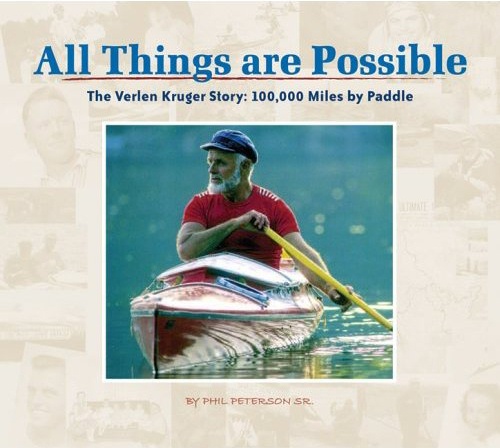Book Review: All Things are Possible
12 Nov


If you’ve recently decided to become the greatest canoe-tripper of all time, to cross continents, to brave coasts, to risk friendships and family to reach your goal … spare yourself.
It’s been done already and it’s unlikely to ever be outdone.
Don’t believe us? Just pick up a copy of Phil Peterson Sr.’s All Things are Possible – The Verlen Kruger Story: 100,000 Miles by Paddle, the biography of a man with the ambition, endurance, and single-mindedness to achieve his full measure of the highs and lows that come from dedicating a life to a single ambition.
All Things are Possible is a veritable Verlen Kruger encyclopedia, tracing his life from birth to death and collecting hundreds of “Kruger Archive” photos to illustrate the book. (There’s even a photo of Kruger’s barn engulfed in flames!). Peterson begins Kruger’s unlikely story with his birth in 1922 in Indiana and follows his life through World War II, when he was a combat flight instructor, through the beginnings of his pre-paddling career in plumbing and the start of his family which would ultimately number nine children.
Kruger didn’t discover canoeing until he was in his forties, but once hooked he took the new pastime as if making up for lost time. In the 1960s he made paddling the centerpiece of family vacations and dove into canoe racing, often with Clint Waddell as his partner.
Racing led to expeditions, and we’re not talking about week-long spins through the Boundary Waters. In 1971 he and Waddell embarked on an 8,000 mile cross-continental paddle from Montreal to the Bering Sea which they completed in 176 days. Using the 55-stroke/minute technique they learned from marathon racing, the pair averaged more than 45 miles of travel per day!
(Still thinking about out-Krugering Kruger?)
From 1980 to 1983 Kruger was occupied, with his son-in-law Steve Landvick, in a 28,000 mile, three-and-a-half year criss-crossing of North America he called the Ultimate Canoe Challenge. The route followed both coasts and included long upstream river stretches. During part of the trip, after Landvick’s infant son died suddenly, Kruger was joined by Valerie Fons.
The relationship with Fons ultimately ended Kruger’s 39-year-long marriage to his wife Jenny in 1984. Fons and Kruger raced down the Mississippi together in 1984, and were married in 1986. From 1986 to 1989 the newly-weds undertook an epic trip from the Arctic Ocean to the southern tip of South America. But Kruger’s second marriage didn’t last long, nor did a very brief third marriage to a woman who, mysteriously, goes unnamed in the book.
The aging canoeman ultimately recognized that his massive expeditions were “warping my judgment.” In his later years, Kruger’s tripping mellowed, somewhat. Multi-year, multi-watershed epics were replaced by length-of-the-Mississippi races and charity events. Kruger ultimately remarried his first wife Jenny in 1997. They remained together until Kruger’s death in August, 2004 at age 82.
Peterson’s book provides a thorough recounting of Kruger’s long, active life. A reader with only a casual interest in Kruger will be tempted to skim over some of the details Peterson provides, but for paddlers interested in sitting in the canoe of a daring, driven, obsessive, tougher-than-bent-nails tripper, the author takes you along for the whole trip.










